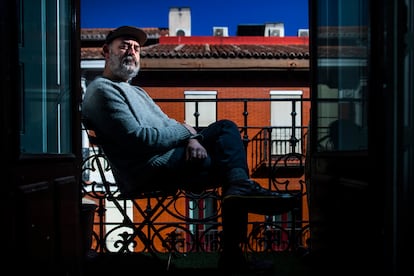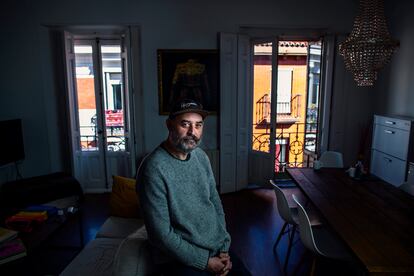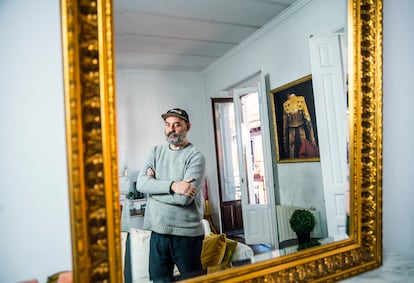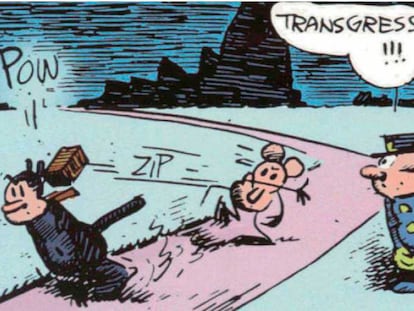Sammy Harkham, beloved cartoonist, publishes ‘Blood of the Virgin’
The graphic novel — 14 years in the making — is the story of a dreamer who tries to make his way in the film industry. It leaves the reader filled with questions about art and life

Los Angeles, 1971. Seymour — after discovering three new gray hairs — endures four hours on public transportation to get to Beverly Hills, in time for a meeting with a studio boss. He didn’t take the car, because his wife needs it to take their son to his nursery school.
“We’ll give you $5,000 for the script. We shoot next week. Your first sale! Congratulations!”
These words — uttered by a producer — upset the life of Seymour, the protagonist in Blood of the Virgin (Pantheon Books). This graphic novel is the work of Sammy Harkham, 42, the renowned editor of the Kramers Ergot comics anthology. He’s been drawing and writing this book for the past 14 years; it’s one of the most anticipated projects on the American comic scene. The title is the same as that of the film script being sold by the protagonist, a 27-year-old man who works as an editor in the low-budget film industry.
Blood of the Virgin comes at a time when hymns to old Hollywood are in no short supply, such as Babylon, The Fabelmans, or Once upon a time in Hollywood. “If you think in terms of how Tarantino deals with [the film industry], he’s indulging in nostalgia,” Harkham notes. “I was trying to get past any romantic notion and get deep enough into it, where it feels as mundane as life today.”

The so-called “exploitation cinema” runs through the work, in which directors’ egos flare up, budgets are scant, scenes are improvised and big bosses abuse actresses. “In this type of cinema, the subconscious is projected even more intensely than in more mainstream cinema… There’s an inherent tension between the world of the films that are being made and the [real lives involved],” Harkham explains, while smoking a cigarette — a habit that his main character is also attached to.
The 42-year-old author was inspired by his parents’ relationship in his creation of Seymour — an Iraqi Jew — and his wife, Ida, the daughter of Holocaust survivors who was raised in New Zealand.
“My parents didn’t stay together, but you know, sometimes I would listen to my father talk about coming to Los Angeles with no money… He didn’t work in the film industry, but I noticed that he talked about his career more than his personal life. I thought that was an interesting dichotomy — how one thing can be [so present], while the other thing can wither on the vine,” the author says.
At one point in the book, the point of view of the narrative switches to Ida. Isolated by motherhood and disenchanted with her marriage, she goes to her parents’ house in New Zealand, in a desperate attempt to recapture what remains of her youth.
“This is part of my parents’ story. My mom went on vacation and decided she didn’t want to come back, so my dad went after her and tried to get her to return. I always found it very funny,” Harkham laughs.
Seymour’s worn-out routine of family life is further upended when he’s given the chance to direct a film, to which he devotes all his energy. The mildew stain in the master bedroom that he promises to remove at the beginning of the book grows bigger and bigger. Harkham delves into the consequences of that neglect: “[For Seymour], success in [the film industry] conflicts with his principles. The end of the book coincides with the end of the production. Seymour is left asking himself, ‘What’s the value of this?’ It becomes a question about how we all think about living. Was it worth all the sacrifice?”
Harkham asked himself these same questions when he finished Blood of the Virgin. When asked if he thinks his graphic novel matters, he pauses for a moment. “I think it depends on the day. You know, I think the one thing literature has always brought to the table of human existence is a perspective and a sense of not having answers. In many ways, what we look for in literature is for all parts of our brain to be able to express themselves without having an answer. I think the joy of literature is that you get to think about all of these things and let them sort of wrestle in your mind.”
In the book, Seymour becomes obsessed with the movie he’s been asked to direct. Harkham had the same obsession when crafting the narrative. “My life revolved around this project. Especially [after the pandemic], I followed an almost monastic existence. It was like tending to a garden for 14 years, slowly watching the plants grow. My entire brain was on it. Even when I was doing my daily tasks — walking my dog, taking my children to school, washing the dishes — my mind was always focused on the book,” he says.

Los Angeles — the main setting for the comic — is presented as the land of opportunities, but also as a cemetery of hope. Harkham, who was born and lives there, although he lived part of his adolescence in Australia, confesses that he’s fascinated by the mythology of the American dream that falls on LA.
“It doesn’t matter which corner of which street I find myself on… I feel the history and the weight from all the expectations of the people who came to the end of the continent to look for a place to find their soul. [This city] contains a lot of disappointment,” he explains.
The interlude that splits the work in two is the only chapter printed in color. It’s a kind of parenthesis from the main plot, in which we follow the story of Joe — a cowboy from Arizona — who moves to Los Angeles in the 1920s and goes from being a set assistant to a mogul in the film industry. The author clarifies his intention behind this chapter: “I wanted it to create visual context for the main narrative. Because — while it seems [as if] we’re following the plot of the cowboy who becomes a film director — behind him, we’re seeing the city [expand] all around him. For example, readers can see that the LA river was a real river, not a concrete reservoir, or that [Native Americans] lived in the hills above the city.”
The more Harkham comments on his graphic novel, the more it becomes clear that he has left nothing to chance… Neither in what he tells, nor in the way he tells it. For example, his character Joe — a blonde guy with an American name, who jumps from landmark to landmark — serves as a counterpoint to Seymour’s trajectory. However, the ending of the book is more ambiguous. The only sure thing is that the three gray hairs that Seymour finds on his head on the first page have turned into a thick mop of gray hair by the epilogue. In the title, the word “virgin” could be associated both with the plot of the film and with the character of Seymour: a dreamer who loses his innocence as the plot unfolds.
Art Spiegelman — author of the masterpiece Maus — offers up his thoughts on this work by a fellow graphic novelist: “A story about storytelling… it conjures up the grindhouse movie-making scene in 1970s Los Angeles and tracks an ambitious young man’s flailing attempts to build a family and a career as a film artist in that debased world. It’s a book with a lot of heart.”
Sign up for our weekly newsletter to get more English-language news coverage from EL PAÍS USA Edition
Tu suscripción se está usando en otro dispositivo
¿Quieres añadir otro usuario a tu suscripción?
Si continúas leyendo en este dispositivo, no se podrá leer en el otro.
FlechaTu suscripción se está usando en otro dispositivo y solo puedes acceder a EL PAÍS desde un dispositivo a la vez.
Si quieres compartir tu cuenta, cambia tu suscripción a la modalidad Premium, así podrás añadir otro usuario. Cada uno accederá con su propia cuenta de email, lo que os permitirá personalizar vuestra experiencia en EL PAÍS.
¿Tienes una suscripción de empresa? Accede aquí para contratar más cuentas.
En el caso de no saber quién está usando tu cuenta, te recomendamos cambiar tu contraseña aquí.
Si decides continuar compartiendo tu cuenta, este mensaje se mostrará en tu dispositivo y en el de la otra persona que está usando tu cuenta de forma indefinida, afectando a tu experiencia de lectura. Puedes consultar aquí los términos y condiciones de la suscripción digital.
More information
Archived In
Últimas noticias
Maduro pleads not guilty before the federal court in New York: ‘I am still the president of Venezuela’
A new test can detect Alzheimer’s from a finger prick
UN team enters Sudanese city of El Fasher after paramilitary massacre: ‘It’s like a ghost town’
A recipe for resistance: Indigenous peoples politicize their struggles from the kitchen
Most viewed
- Gilles Lipovetsky: ‘If you want to live better and fall in love, take Prozac, don’t look to philosophy’
- Alain Aspect, Nobel laureate in physics: ‘Einstein was so smart that he would have had to recognize quantum entanglement’
- Alvin Hellerstein, a 92-year-old judge appointed by Bill Clinton, to preside over Maduro’s trial in New York
- Why oil has been at the center of Venezuela-US conflicts for decades
- Maduro’s downfall puts China’s relationship with Venezuela to the test

!['Querido Callo' [Dear Callus], by Aline Kominsky-Crumb](https://imagenes.elpais.com/resizer/v2/MEX7PPUO2JDM5G4PYGD3ELX6DE.jpg?auth=fab96fcd5f21f8f43f12654c628f80d03a5e0f0acd678d5f6ce03af63af9046f&width=414&height=311&focal=437%2C318)









































